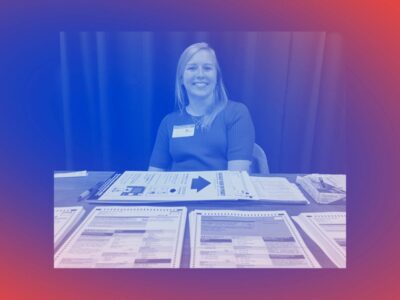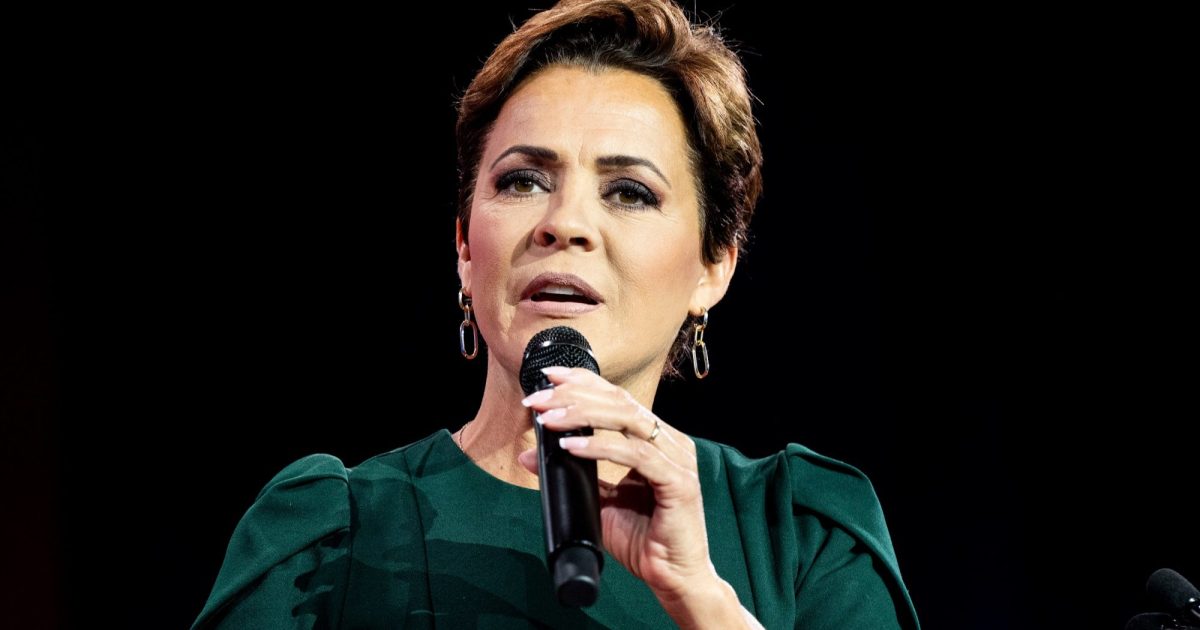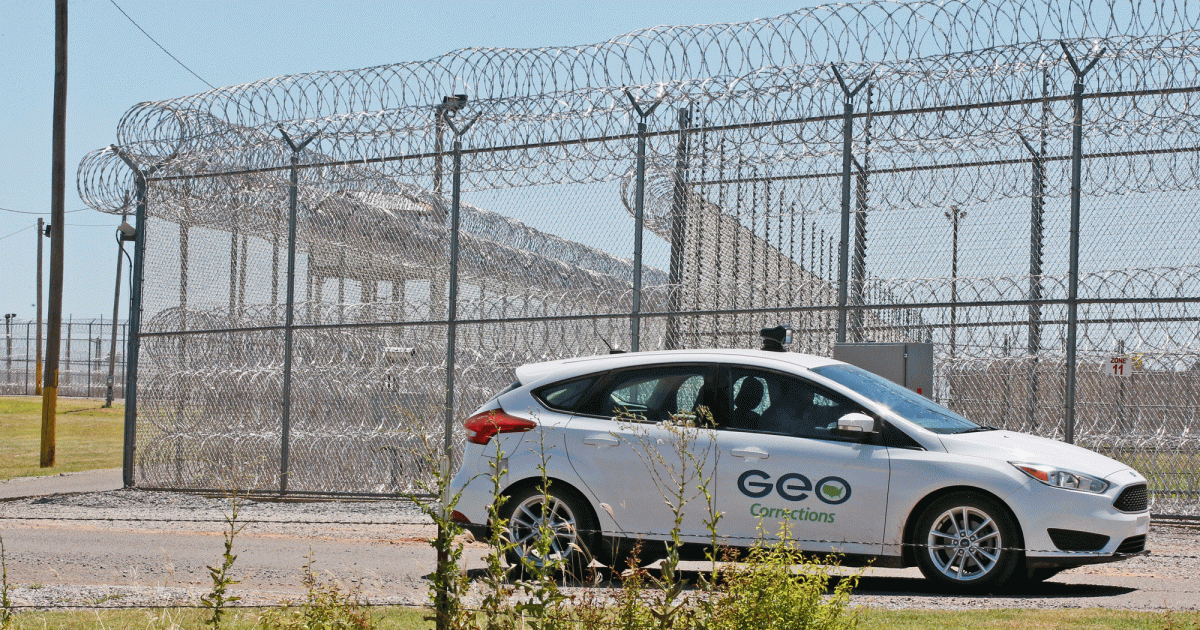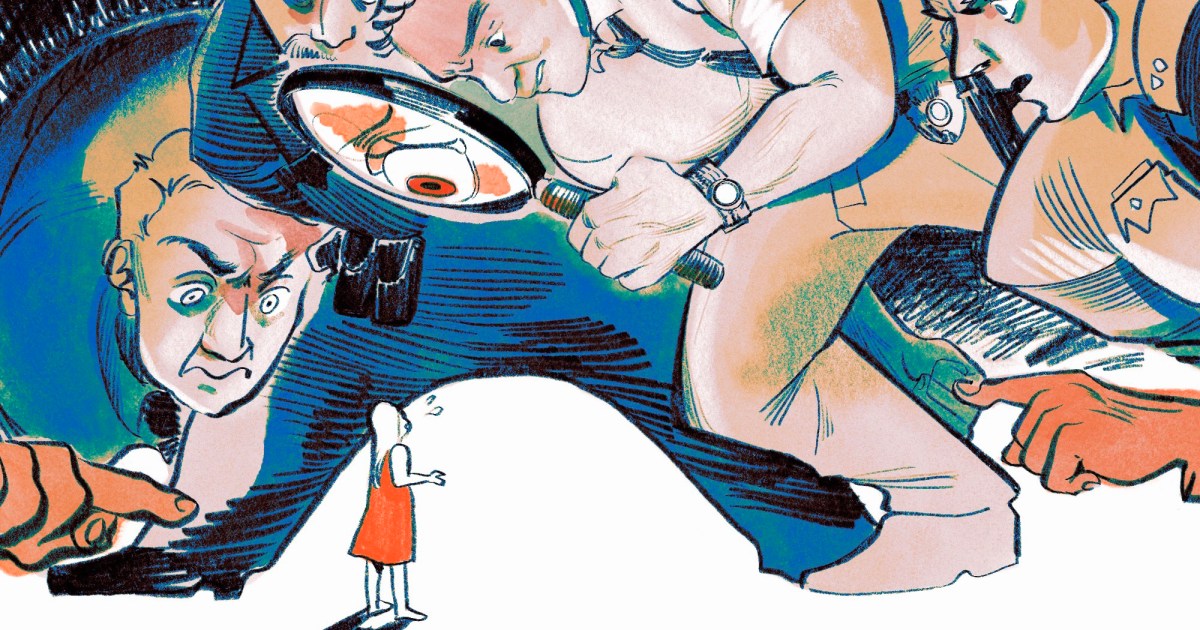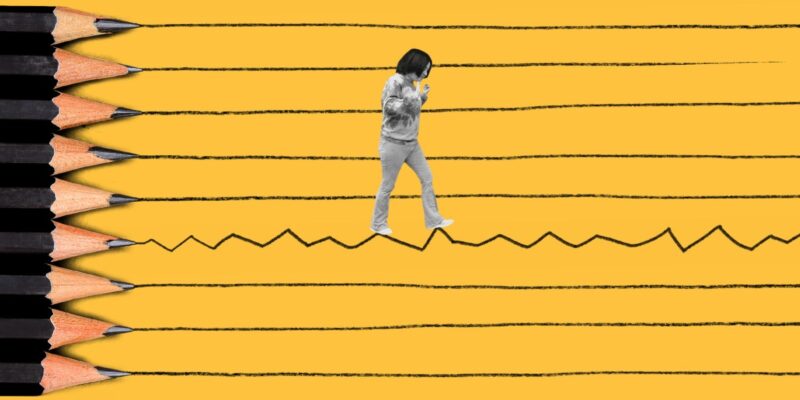
I love looking at pictures from my daughter’s first day of preschool. Three years old, wearing a dress with pink apples on it. I had perfected getting her hair into pigtails just a few weeks before. There was something joyous and hopeful about those little hair geysers sprouting straight off her head. In the photos from that day, we look like any other family on the first day of school. My boys, ages 4 and 6, wearing new future-oriented pants that look a little too long, are smiling proudly at the thought of their sister joining them. It was raining and unseasonably cold; our raincoats seemed out of sync with our end-of-summer tans. In one picture, Mae is leaning into my lap, her yellow raincoat and pigtails buried by my scarf as I give her one last kiss.

We appeared to be a conventional family from afar, but we weren’t. Mae wasn’t like my other two children. She made repetitive noises and movements, barely slept, never spoke, and seemed plagued by a never-ending carousel of ear infections and rashes. When she started school, she was classified as PDD-NOS, or “pervasive developmental disorder-not otherwise specified.” Although she was 3 years old, developmentally, her age was estimated to be between 13 and 17 months. A month after her first day in preschool, she was officially diagnosed with autism. With the right therapies and some good luck, we were told the gap between our daughter and her peers might be narrowed—if not closed. So, for the next decade, we did everything we could to solve the puzzle that was our daughter’s brain: hours and hours of therapy, specialists, the occasional snake-oil salesperson, chat rooms, lawyers, and—yes—the public school system.
That was 14 years ago. Mae has grown into a young woman who loves music, bubble baths, and peanut butter. She can get a map of a place in her head in seconds and can quickly scan a room and identify who would be most likely to bend to her needs. In other ways, though, her developmental age is still under 2 years old. She is still in diapers; she communicates with hand gestures and noises that make perfect sense only to those of us who know her. As her older brothers’ academic and social lives have traced the predictable trajectories of adolescence, hers have been characterized far more by what hasn’t changed than what has.
This is where the current model of education for children with disabilities is a mismatch for her: Even though her developmental age is that of a preschooler, well-intentioned policies known under the blanket term of “inclusion” put her in a building of high school students with whom she has little in common.
My daughter’s school-based occupational therapist and I have often spoken wistfully of a school site with an OT space where students could learn practical life skills, where my daughter would spend her days learning to make a peanut butter sandwich or brush her teeth or make a bed or comb her hair. Or, most importantly, learn how to take herself to the toilet. The hours and hours she and I spend together in the summer on potty training are paused every time school starts. It is lovely to think that putting her in a small classroom adjacent to neurotypical students would somehow improve her experience. However, if she learned through osmosis or observation, she would be someone else altogether.
Still, I see this issue from two perspectives. I am the parent of a child with complex needs—and for the last eight years a general education middle school teacher. I believe that she has every right to a high-quality education in our public school system. I also believe, however, that what she learns is more important than where she learns it. The gap between my daughter and her neurotypical peers has grown into a galaxy. I am pretty sure she does not look at the long-legged teens twirling car keys at her school and wish she were one of them. (I think one of the gifts of her condition is that envy or insecurity aren’t part of her experiences.) But one of the liabilities of including her in classes with her chronological peers is that the important life skills that she lacks are not on the curriculum.
Students in my classroom also have a range of needs; some are neurodivergent, others aren’t, but none of them have demands as complex as Mae’s. As a parent and as an educator, I have been increasingly troubled by the gap between good intentions and lived experience in our schools, one that seems especially sharply drawn with children like my daughter. This question of where a child with disabilities learns and with whom is deeply complicated, in part because the term “disability” is applied very broadly. It now includes everyone from a child with mild dyslexia or similar processing issues to a child like mine. Is there a unified strategy that can meet these varied needs? Have we progressed from a time when children like my daughter were shut away from society to the present day when we use the myth of inclusion to mask the fact that we are still not truly creating schools to meet the needs of all children effectively?

Inspired by the desegregation of schools and the civil rights movement, in the late ’60s and early ’70s, disability rights advocates started pressuring Congress to address education for children with disabilities. Leading disability rights activist Judy Heumann, who worked with a congressional team to draft legislation, recalled in her book Being Heumann: “The country was so inaccessible, disabled people had a hard time getting out and doing things—which made us invisible.”
Disability rights activism changed this. Back then, many children with disabilities never went to school at all. There was no expectation that a local public school could or would meet their needs. In 1975, the Individuals With Disabilities Education Act, known as IDEA, passed. The New York Times around that time quoted Dr. Philip R. Jones, president of the Council of Exceptional Children, describing the measure as “a landmark for education of the handicapped in our country,” adding, “It is overcoming 200 years of sin.” After describing the bill’s emphasis on individualized curricula, the Times also reported: “Another sensitive portion of the legislation deals with what has come to be known in education as the issue of mainstreaming. That is the extent to which the handicapped should be isolated in classes of their own or mixed in the so-called mainstream with the nonhandicapped.”
Today, nearly 50 years later, across the United States, there are 7.3 million children with disabilities currently receiving services in the public school system, according to the Pew Research Center. They represent about 15 percent of all public school students. IDEA seeks to help them by mandating “free and appropriate education” for all children and requiring that students be educated in the “least restrictive environment,” or LRE. The law states that “to the maximum extent appropriate, children with disabilities, including children in public or private institutions or other care facilities, are educated with children who are not disabled.” LRE is descended from another legal standard—the least restrictive means test, which is used any time a law or government may impede on a person’s civil liberties. These days, it’s often the rationale for placing children with disabilities in schools with their chronological peers—often referred to as “inclusion or mainstreaming.”
Broadly speaking, authentic inclusion of disabled children is necessary and important because, just as with any child, these children are as deserving of a high-quality education that meets them where they are. But for my daughter, and for children with similar profiles, the practical effect is that, rather than spend her days on skills she needs—brushing her hair and teeth, going to the bathroom—she spends them in a large public high school, sitting in a classroom located beside a loud, distracting cafeteria, working on some pseudo-academic curriculum that is based on videos of current events. The thought of her sitting and watching videos on the marvels of weather and then being asked to fill out a worksheet on what she just watched is absurd. Her worksheets about tornadoes or growing potatoes appear to have been scribbled on by a toddler.
The thought of her sitting and watching videos on the marvels of weather and then being asked to fill out a worksheet on what she just watched is absurd. Her worksheets about tornadoes or growing potatoes appear to have been scribbled on by a toddler.
As we have seen, in practice, the whole concept of LRE is often reduced to the setting where a child learns. But Dr. Mitchell Yell, a professor at the University of South Carolina and an expert on legal issues in special education, explains: “It is actually much more than that. It’s the facilities, personnel, and location. It’s a web of services.” When I asked Yell about how the concept of LRE had come to represent a physical place, he said he wished they had instead called it “LRAE—least restrictive appropriate environment.” He added, “Perhaps then the emphasis would have remained on what is appropriate for that individual child, rather than simply what was available.”

As a teacher of social studies, I see 86 middle school students a day; at any given time, I can have as many as 35 in a class. In order to succeed, one of them may need to sit in the front row away from his peers, while another may need to be in the same seat every day flanked by his best friends. One may never remember to bring his backpack, so may need to keep a folder in the room and a steady supply of pencils and other reminders; another may complete every assignment the day that it is given and ask for additional reading. Teachers are like short-order cooks serving up our subjects. At best, we can tailor every lesson, assignment, fact, and expectation to the child in front of us. It is why the job is both so hard and so rewarding. When you crack the code of how a kid learns, you open up some small but important part of the world to them.
About two-thirds of children with disabilities are included in the same classrooms as their general education peers. Some, with dyslexia, for instance, or ADHD, have modified assignments, tests without time limits, or support for note taking; others are pulled out for speech or OT services. In some cases, students are accompanied by one-to-one aides. For the most part, these students are able to operate in a general education classroom and still get the support they need.
Children like my daughter, whose needs are more complex, tend to be in “special day classes” (SDCs), usually in the same building as their typically developing peers but in a dedicated classroom. Part of the intention of LRE was to avoid the segregation of people with disabilities, so they could attend their neighborhood schools and build relationships in their community. Plus, these schools already exist, equipped with cafeterias, art rooms, and athletic facilities. It is far less expensive for districts and counties to tuck disabled children on the edges of existing facilities than to really address their needs.
I live in Northern California, and the SDCs are managed by the county, not the local school. In functional terms, the county-run SDC is a guest at the high school, but local school or general education teachers have no authority or responsibility to monitor what is happening in that classroom. I have often worried about Mae’s safety in these siloed little classrooms an hour from our home with no daily on-site administration. Her program manager visits her class twice a week, and that is the only oversight or accountability for the teachers and staff who work with her.
Midway through the last school year, we got word that our daughter was struggling in class—huge tantrums every day, screaming, crying, hitting herself. We learned about this because the school nurse reached out to ask whether we were seeing the same behaviors at home (we were not). Only then did I learn that her dedicated one-to-one aide had been away from the school for a month. (My daughter, of course, was not able to tell us.) Then we learned that some complex medical issues would keep the head teacher out of the classroom for the rest of the year. Plus, the program lacked a consistent occupational therapist. The replacement teacher had no teaching credentials at all, let alone experience with children with disabilities. I was told by a county administrator that the replacement teacher’s wife had taught disabled children, so I needn’t worry. The result was that Mae spent most of the school year in a classroom without a credentialed teacher and with a rotating cast of occupational therapists. Had it not been for the consistency of her one-to-one aide (who returned after the first month of school), my nonspeaking child would have found herself surrounded by under- or unqualified strangers.

When parents believe that schools are failing to provide an appropriate education for their child, they can sue for a better placement or services, such as a special school or home-based care or what is classified as “most restrictive,” which means a hospital or residential facility. Unsurprisingly, parents with resources tend to be able to hire lawyers and advocates so their children will have access to specialized private schools or obtain additional services and support. In some cases, these parents can get public funds to cover the cost of a private school that best meets the needs of a student, though this puts heavy financial burdens on school districts and creates serious equity issues.
Inclusion works well for some children with significant disabilities. Not long ago, I spoke with Janee Adams, whose daughter Ruby has Down syndrome and recently graduated from high school. Ruby went to a large public high school in her district, where her mother said she “got to be one of one, everyone knew her.” However, Adams had to fight every step of the way. She hired an advocate and created alliances within the school community so other parents supported Ruby’s presence in the classroom. With Adams’ daughters so close in age, they often were in the same class—one of the reasons Ruby loved school. Some of the more challenging social elements of inclusion were easier because the girls could have friends sleep over at their house together. Now that Ruby has finished high school, Adams told me that she is in a day program that has helped her find employment and holds her accountable in ways that often didn’t happen in school. “Ruby loves it,” Adams says. “She has never been in a place where she completely belonged before, and she is just so happy.”
Our family also has had experiences when inclusion was truly remarkable. Two years ago, my daughter’s teacher collaborated with the theater teacher to create a performance that was written and performed by both general education students and the students in Mae’s class. When the play began, Mae was sitting on a couch while Nirvana blasted through the speakers. She loves music and the students working with her had realized that Nirvana was a special favorite. The student actors would weave it into their story when occasionally Mae would jump up off the couch or laugh loudly. It was a wonderful experience to be at my daughter’s school for something other than a meeting, where the typical kids described how much they learned from working with their disabled peers. In our home, my sons have gained so much from having a sister with complex needs. Their friends who have grown up with Mae also display a level of understanding and empathy that only comes from authentic relationships.
“I feel like I’m stuck in a cage with only special needs students that can see me and interact with me. And the mainstream girls think I’m invisible.”
Some school districts offer a partial inclusion model for students who fall in between inclusion and SDC, where students with disabilities share some low-intensity classes—such as PE or art— with their typically developing peers but are sequestered in other classes for academic programs. I spoke to a neurodivergent student who attends one such program at the large public high school from which my sons graduated. She also holds a job at a local smoothie shop. “I met these mainstream girls last year in PE who I wanted to be good friends with because we had a good conversation,” she told me. “I don’t think they knew how to interact with the neurodivergent kids.” She continued: “I feel like I’m stuck in a cage with only special needs students that can see me and interact with me. And the mainstream girls think I’m invisible.”
She may take PE or electives with her neurotypical peers, but when she wanted to take the genetics section of a science class or manage the swim team, she was told she could not. When her parents pushed back, they were told that the coach of the team did not have the capacity to have her on as a swimmer or manager. They were told that the science class was “not a good fit” even though their daughter had independently done hours of research about her own chromosomal deletion. She longs to be included in the daily goings-on at the school, but without the concerted efforts of both students and staff, she and her peers will operate as though they are of a different caste—functional enough to be adjacent to their typically developing peers, but never admitted into what seems to be an exclusive club.
Without standards to define or measure “inclusion” or its benefits, it becomes one of those educational policies that sound good on paper but are rarely as beneficial to the students they are designed to help. When we make inclusion the goal over excellence, we are “putting the where before the how,” says Douglas Fuchs, a leading researcher on human development and education for children with disabilities at Vanderbilt University.
Fuchs told me his research team created a national database of reading data from 1998 through 2015 for students grades K-12. After analyzing the data using “multilevel growth models,” they found “that mainstreaming, or general classroom placements, did not strengthen the academic achievement of most students with disabilities.” In 2022, the Campbell Collaboration, an international research organization, published a report saying inclusion did not seem to show any positive academic or social-emotional benefit to students. In fact, students who were taught separately in settings designed for them experienced better outcomes.
The longitudinal studies are clear about how blanket policies of inclusion can actually inhibit student progress. In summarizing what we know about inclusion, Fuchs says, “Fifty years of research indicates that placing students with disabilities in general classrooms fails to provide the necessary intensive and expert instruction these children and youth need to succeed in school and in life afterwards.” This means that for some students, the general classroom is an appropriate placement, but for many, there need to be other school-based options that are better suited to meet their specific needs.
“Fifty years of research indicates that placing students with disabilities in general classrooms fails to provide the necessary intensive and expert instruction these children and youth need to succeed in school and in life afterwards.”
In my classroom, there were students with various diagnoses who spent most of their days in general education and were able to follow much of the curriculum. I have seen moments of enormous grace: when students connect over a beloved video game or when a child with autism will blurt out a question that their peers are too shy to ask. For a moment, they are a hero. I have also cringed as the same child picks their nose, not noticing that their peers are recoiling, or doesn’t realize that the clothes they refuse to change may smell. The parent in me dies a little every time I catch the flicker of irritation on a student’s face at the thought of having to work with a peer with disabilities. Or when I look out at lunch and see clusters of students all over campus and then one or two lone kids not really excluded, but not fluent in the language of adolescence. I have often wondered whom our well-intentioned efforts benefit. Do the kids really learn to be tolerant of people who are different than they are? Do kids with disabilities learn to live more easily in the world simply because they are surrounded by it?
I know they sometimes feel left out, aware that there are sleepovers they don’t attend and jokes they will never get. Are those painful feelings worth the experience of being in their local public school classroom? I’ve seen how students with complex needs can often confirm the biases of their peers by behaving strangely or having inappropriate outbursts in the classroom. It is one thing to be polite to a kid with disabilities in the context of your eighth-grade classroom; it is another to invite them to your birthday party.

So what would the best option be? I asked Bill Koski, the founder of Stanford’s Youth and Education Law Project, about which country might have the most advanced models for raising children with disabilities. Finland, he said, thrives at addressing the needs of very different learners by focusing more on integration than inclusion. He explains that there is no “labeling and classification” of students, but “three tiers of intervention” for those who are struggling: general support, intensified support, and specialized support. “As a result,” he says, “a fairly high percentage of Finnish students receive interventions for children with disabilities.” No matter where or who they teach, good teachers do this instinctively, but what sets Finland apart is that it has normalized the concept that every learner has an individual style and those needs should be met by a highly qualified staff of teachers.
Only students with the most complex needs aren’t in classrooms with their peers. A child like Mae would probably stay with her peers through early childhood and then move to a school or classroom where she could be taught life or vocation skills appropriate to her developmental level. One reason this system works is because it’s well funded; the idea that every student needs to learn life skills and independence is seen as fundamental for all students—and a long-term benefit to society at large.
When the focus of education is the integration of all learners, the idea that everyone is worthy of an education is reinforced for both students and families. Even without a national initiative, there are models for children like mine that could work in any school district. One of them is a school within a school. The current model in my county puts one teacher for children with disabilities at a school with their own classroom—an island of “special” in a world of general. What if there were three or four classrooms for children with disabilities on the site of a general education school? The focus could be on providing authentic inclusive experiences when it was appropriate and on fostering independent living skills. Perhaps the general education students could even work with their disabled peers on building those life skills, like, for instance, figuring out how to manage a small business or practice some simple cooking techniques.
Paul Owens is the principal of Cedar Lane School in Fulton, Maryland. Sharing a campus with a middle school and located down the road from a high school, Cedar Lane offers a kind of school-within-a-school model. Owens described “buses going back and forth all day” and said all three school sites share a music and art teacher, allowing for the kind of authentic inclusion that my daughter experienced in last year’s theater program. By having a disabilities school within a general education school, districts would be able to provide better oversight, consistency of staffing, sharing of institutional resources and knowledge, and authentic, thoughtful experiences of inclusion as opposed to just proximity.
When I asked Owens what he would wish for Cedar Lane School, I expected his answers to be predictable: probably more money and more staff. Instead, he said, “I wish my staff had more time for connection instead of compliance,” which is to say spending more time building relationships with students and families and less time on the cumbersome paperwork that defines education for children with disabilities. He added that he wished they could be more effective in helping students transition out of Cedar Lane at the end of high school. For many students with disabilities, graduation from high school is the end of a clear path of state-run services. “Once students graduate and leave Cedar Lane,” he said, “the availability and quality of services is inconsistent and support for students and families is very limited.”
“Once students graduate and leave [school], the availability and quality of services is inconsistent and support for students and families is very limited.”
As Congress is winding down this session, Rep. Jared Huffman (D-Calif.) and Sen. Chris Van Hollen (D-Md.) have sponsored a measure to fully fund IDEA. I asked Huffman what this measure could mean for students with disabilities in this county. For him, the question is personal. He is also a “special needs parent,” he said. In the unlikely event that this bill were to pass, the burden on school districts and counties would be eased considerably, with the federal government funding up to 40 percent of the cost of educating students with disabilities, in contrast to the approximately 14.7 percent of costs that are covered today. This means that in the 2022–2023 school year, counties, states, and districts had to make up a $23.92 billion gap between what the federal government funded and what it would be funding if it committed to the originally intended 40 percent.
As Huffman said: “Every student deserves a quality educational experience, regardless of their physical or developmental disabilities. What’s been missing is the money to make that happen.” Fully funding IDEA would signal to schools and families that the federal government is invested in students with disabilities. However, without high standards for training teachers, precise definitions of concepts like inclusion, and nationwide standards for services that children with disabilities receive, the system may still perpetuate inequity by offering the minimum to those who need it most.
When we insist on the pseudo-inclusion of proximity, my daughter’s humanity gets lost. Mae is not her age, nor should she become some symbol of vulnerability used to teach empathy to those fortunate enough to drive cars and spend hours on TikTok. She is a person who deserves an education that meets and acknowledges her specific needs, that focuses on best practices and authentic, inclusive experiences that help her develop the skills she will need to be as independent as possible. When parents fight for full inclusion, what they really are fighting for is the recognition that their child is as valuable as anyone else’s. When the focus is compliance over consistency, when chronological age overshadows developmental needs, and when we say we want to foster empathy but instead confirm second-class citizenship on those for whom appropriate is all we are willing to concede, we send a clear message to children and families like mine about their value.






